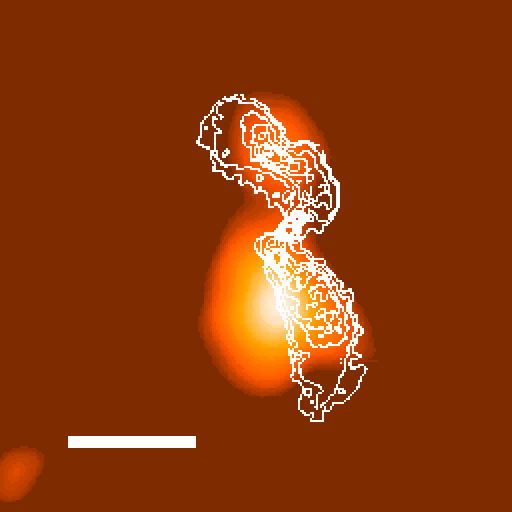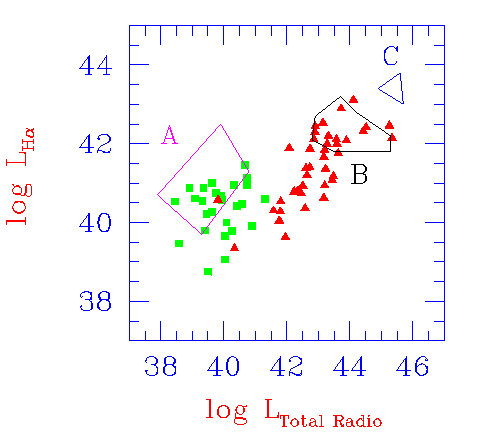Carrillo, R.1, Cruz-González, I.1
and Guichard, J.2
1 Instituto de Astronomía, UNAM, México
2 Instituto Nacional de Astrofísica, Optica y Electrónica, México
Results of a search for extended optical emission-line gas of 26 weak radio galaxies is presented. Emission is detected in all galaxies and extended regions are resolved in 81%, with mean sizes of 4.6 kpc. Morphologies are predominantly oval or elliptical with a central condensation of kpc in size and in some cases there are filamentary structures at several kpc from the nucleus. The estimated luminosities, density and mass of gas of the weak radio galaxies are similar to those of powerful ones. It is proposed that also in weak radio galaxies the central source is responsible of the gas ionization and that the observed gas has been acquired by fusion or interaction of galaxies, with at least one rich in gas.
It is now well known that some radio galaxies and some quasars have extended emission-line regions (heron, EELR) which is extended on scales of tens of kpc. In some radio galaxies there is convincing evidence that the kinematics and excitation of the very EELR is governed by its interaction with the radio jet. However, in other radio galaxies the evidence for an interaction is much weaker, and the ionization of the EELR may be predominantly produced by the nuclear UV continuum and the kinematics of the gas by the gravitational potential of the host galaxy.
We have obtained optical broad-band (V, R, and I), narrow-band
(H![]() +[NII] and/or [OIII]), and infrared broad-band (J, H, and
K'), images of a sample of weak radio galaxies (WRG). We also used data
available in the literature to study the association between the EELR and
the radio structure.
+[NII] and/or [OIII]), and infrared broad-band (J, H, and
K'), images of a sample of weak radio galaxies (WRG). We also used data
available in the literature to study the association between the EELR and
the radio structure.
The details of our study of EELR in WRG are presented in Carrillo, Cruz-González & Guichard 1997, 1998.
The observations were carried out at the 2.12 m telescope of the
Observatorio Astronómico Nacional at San Pedro Mártir, B. C., México.
CCD images were taken through narrow-band filter centered on either
H![]() +[NII]
+[NII]
![]() ,
and/or [OIII]
,
and/or [OIII]
![]() .
Two
Thompson CCD detectors were used: 384
.
Two
Thompson CCD detectors were used: 384![]() 576 and 1024
576 and 1024![]() 1024, which with the f/7.5 secondary yield an image scale
in the focal plane of
0.3''/pixel and 0.25''/pixel, respectively, so that the field of view is
1.93'
1024, which with the f/7.5 secondary yield an image scale
in the focal plane of
0.3''/pixel and 0.25''/pixel, respectively, so that the field of view is
1.93'![]() 2.89', and 4.25
2.89', and 4.25![]() 4.25' in each case.
4.25' in each case.
Typical observation times were 30 min to 1 hr. A set of standard stars from Oke's list, were acquired each night for photometric calibrations. The reduction of the two-dimensional CCD frames follows the standard procedures. The Image Reduction and Analysis Facility (IRAF) software was used.
In this work, we present the results of a program of optical
observations in narrow-band filters, H![]() +[N II]
+[N II]
![]() 6548,6583
and [O III]
6548,6583
and [O III]![]() 5007, of a sample of 26 weak radio galaxies. The main
results can be summarized as follows:
5007, of a sample of 26 weak radio galaxies. The main
results can be summarized as follows:

Fig. 1. B2 1346+26 color representation of the [O III]![]() 5007 line
emission overlayed with
the radio emission (contours) at 6 cm (van Breugel, Heckman & Miley 1984).
North is up and east is to the left. The bar corresponds to 5''
5007 line
emission overlayed with
the radio emission (contours) at 6 cm (van Breugel, Heckman & Miley 1984).
North is up and east is to the left. The bar corresponds to 5''

Fig. 2. Plot of log L
Total Radio and
log L
![]() for different types of AGNs:
for different types of AGNs: ![]() our
sample of WRG;
our
sample of WRG; ![]() PRG (Baum & Heckman 1989a);
(A) region Seyfert galaxies (Whittle 1985; de Bruy
& Wilson 1978); (B)
the zone of steep-spectrum quasars (Stockton & Mac Kenty 1987);
and (C) region of high redshift radio galaxies (Spinrad 1987).
PRG (Baum & Heckman 1989a);
(A) region Seyfert galaxies (Whittle 1985; de Bruy
& Wilson 1978); (B)
the zone of steep-spectrum quasars (Stockton & Mac Kenty 1987);
and (C) region of high redshift radio galaxies (Spinrad 1987).